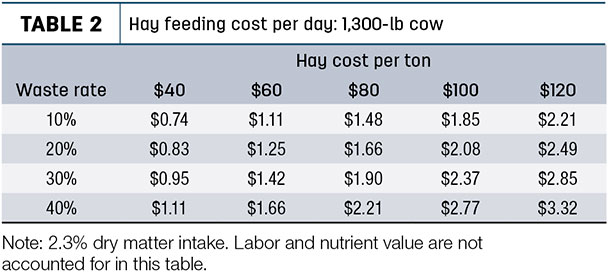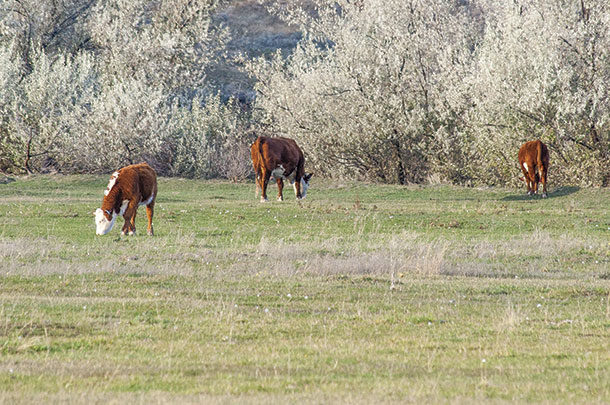Picking apples off the grazing tree: When grazing isn't profitable), we went over extended season grazing at a conceptual level to help intuitively understand that as we push extended season grazing further into the winter, the cost of those additional grazing days keep increasing until, at some point, the cost to feed hay will likely be a cheaper option.
This month, we will analyze two of the most common methods used in the upper South to extend the grazing season: More intense pasture rotations to increase utilization of forage in the fall/winter and stockpiling forage and increasing fall yields with applied nitrogen.
We will evaluate situations in which they can be profitable and how far we can push them.
Increasing grazing intensity
Increasing the intensity of your pasture moves will increase utilization of the forage base to some degree. In spring and early summer, there may not be much advantage as most farms have too much forage at those times. However, increasing utilization of pastures starting in early fall will result in the need for less winter hay feeding.
There is a diminishing marginal return related to grazing intensity. Going from continuous grazing to rotational grazing where we move once every two weeks will greatly increase utilization.
Going from every two weeks to once-per-week rotations would also increase utilization but to a lesser degree. Moving to twice-per-week rotations would further increase utilization, but again the gain keeps diminishing. At some point, the gains diminish enough so they do not pay for the added costs of more intense moves.
For example, assume we go from moving cattle every three days to moving them daily and value our labor at $15 per hour. Here are the additional labor costs over a three-day period given various times for a pasture move:
30-minute moves x 2 extra moves = 1 hour
1 hour x $15 per hour = $15 additional cost
45-minute moves x 2 extra moves = 1.5 hours
1.5 hours x $15 per hour = $22.50 additional cost
60-minute moves x 2 extra moves = 2 hours
2 hours x $15 per hour = $30 additional cost
With a 50-cow herd, these would be the additional grazing days we would get during that three-day period given three different increases in utilization:
5 percent increase in utilization = 2.5 extra grazing days per day
3 days x 2.5 grazing days = 7.5 extra days
10 percent increase in utilization = 5 extra grazing days per day
3 days x 5 grazing days = 15 extra days
15 percent increase in utilization = 7.5 extra grazing days per day
3 days x 7.5 grazing days = 22.5 extra days
Now we just need to value the additional grazing days. In this case, the value will be the forgone cost of feeding hay multiplied by the extra grazing days gained from increasing utilization.
Table 1 shows the corresponding benefits and breakeven move times for various increases in forage utilization assuming a $2-per- day cow hay feeding cost.

Thus, if you expected a 10 percent increase in utilization, you would need to spend no more than 60 minutes per move on average for the daily moves to be profitable. A range of increased utilization are included. (There are no studies that have evaluated this conclusively.)
Based on personal experience, I would use an increase between 5 and 10 percent, going from three- to one-day moves. Table 2 shows a range of hay feeding costs for a 1,300-pound cow given various hay prices and hay waste rates.

The previous analysis assumed a 50-cow herd. If you had a 25-cow herd, the cost effectiveness of this practice would be more challenging. We would effectively be getting 50 percent less extra grazing days per move, so the benefits would be cut in half (Table 3).

Basically, we can only spend half as long moving the cattle compared to the previous example for the daily moves to be cost-effective. If we had 100 cows, it would be reversed. We could now spend twice as long moving cattle compared to the 50-cow example for the practice to be cost-effective.
The most important point of this analysis is: A “one-size-fits- all” approach for many grazing recommendations does not work. What will profitably extend the grazing season on one farm may be unprofitable on another farm. The number of cattle in the herd, and the time it takes to move the cattle, are the major factors in this determination.
You can afford to move large herds more than you can small herds. If your pastures are set up with good infrastructure for efficiently moving cattle, you can afford to move those cattle more often than on farms where it will take longer. It also matters how you value your time (or the labor rate you are paying an employee).
The previous analysis assumes a labor rate of $15 per hour, and the costs would change proportionally based on other labor rates.
A second important point is: Regardless of the herd size, labor rate or hay cost, as we try to push utilization to higher levels, we are also going higher and higher up into the grazing tree. The cost for a grazing day keeps increasing to the point where feeding hay would be a cheaper option for most farms.
Making broad-based statements that imply grazing is always cheaper than feeding hay may inadvertently lead to reduced profits once we have moved to higher grazing intensities.
Grazing options
Stockpiling tall fescue pastures is another approach used to extend the grazing season in the upper South. Here the pasture is set aside in early to mid-August, nitrogen is applied to boost growth, and the pasture is rested until the end of the growing season.
If we apply 50 units of nitrogen (N; or 109 pounds urea) per acre, and get 20 pounds dry matter response per unit N (good soil moisture conditions), we would grow an additional 1,000 pounds of forage per acre on a dry matter basis. Assuming we utilize 70 percent of this, 700 pounds per acre would be our effective gain from the nitrogen, and an average cow consuming 25 pounds of dry matter per day would give us 28 extra grazing days per acre.
If nitrogen costs 35 cents per unit, this would amount to $17.50 per acre for the nitrogen. If it cost $5.50 per acre to spread it, our total cost for the nitrogen application would be $23 per acre.
Dividing the total cost by the 28 extra grazing days works out to a cost of 82 cents per extra grazing day. This is much lower than a typical hay feeding cost of $1.25 to $2 per day per cow; thus it looks like an attractive option. If, for example, a hay feeding day cost us $1.50, we would appear to be saving 68 cents per day for each cow.
However, unless we were highly understocked by conventional standards, we would not likely have any excess pasture to set aside in August in a typical year. On most farms, pasture growth has slumped by this time, and we need all of our pastures in the rotation.
The only way to be consistently able to stockpile pasture on most farms is if we permanently reduced our stocking rate, which is a cost in its own. Thus from a practical standpoint, applying nitrogen and setting aside stockpiled pasture will only work in years where late-summer pasture growth is well above average.
If we reduce our long-term stocking rate to be able to consistently set aside fall pastures, we would also need to account for the loss in profit from the destocked animals.
How much will the reduced stocking rate cost us? This will be the focus of the next article, where we evaluate the most profitable stocking rate for a cow-calf operation. It is possible the combined cost between the nitrogen application and the loss of profit from the destocked animals will exceed the benefit. It needs to be evaluated on a case-by-case basis to know for sure. ![]()
PHOTO: Grazing intensity, labor, hay feeding costs and stockpiling options all play a part in the evaluation of whether grazing an extra day is profitable. Photo by Paul Marchant.
Greg Halich is an associate extension professor at the University of Kentucky. Email Greg Halich.










